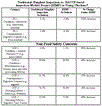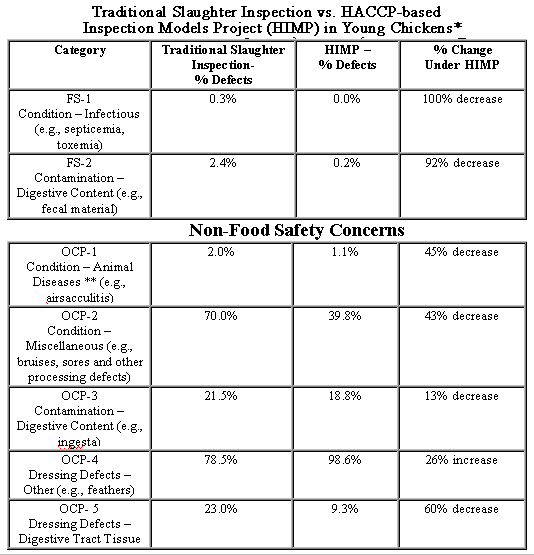FSIS responds to HACCP-Based Inspection Models (HIMP) criticism

In response to what the Food Safety and Inspection Service (FSIS) calls "a campaign of misinformation" regarding the government's new HACCP-Based Inspection Models, FSIS Administrator Thomas J. Billy yesterday released the following statement:
July 19, 2000
I have scheduled this press briefing to stop what I consider to be a campaign of misinformation. While I recognize that these are harsh words, I cannot allow irresponsible journalism to misrepresent to the public the gains in food safety and other consumer protection concerns that we are achieving.
Reports in the media stating that the Food Safety and Inspection Service is putting out new rules permitting animal carcasses with defects to enter the food supply are absolutely false. The notion that we are now allowing product to bear the mark of inspection that wasn't permitted to bear the mark before, is a plain misrepresentation of the facts. The union leadership misrepresented the facts when talking with the media, and their statements conflict with those we have received from inspectors in the pilot plants who support the new system. If the media had contacted our office to receive our input before publishing these articles, we would have been happy to present the facts. Because they didn't, I am presenting them now.
We are pilot testing a new system of inspection that raises the bar for food safety and other consumer protection concerns. Before the HACCP-based Inspection Models project began, we had not ever measured the accomplishments of the traditional inspection system we have carried out in slaughter plants since 1906. Now we have, and the data tells us there is plenty of room for improvement. Too many defects are getting through the traditional slaughter inspection system. This includes defects that are food safety related, and defects that are not food safety concerns but that are unacceptable to the public. Consumers deserve better.
With this pilot project, we have put both types of defects - food safety and other consumer protection - into categories, and set performance standards for them that plants must achieve. This does not mean that defects unacceptable under the traditional slaughter inspection system are now acceptable, as has been reported. The things we condemn under traditional slaughter inspection are the same things we condemn under the new system. Just as with the traditional system, FSIS provides continuous inspection under the pilot. The pilot also adds enhanced verification to ensure that these standards are met.
Plants have more responsibility under the new system to ensure their operations are capable of meeting these standards. But it is still our job to inspect, to verify, and to decide what products have earned the mark of inspection. We are not standing on the sidelines watching others play the game.
The new system also allows plants to take advantage of new technology to improve food safety, and that's why we've gotten such good results so far. Dr. Beckman, an inspector-in-charge at one of the pilot plants, who is here today, told me that the plant he is assigned to has made major technological improvements, and the result has been a better product.
If you look at the preliminary data we have analyzed, some of which is represented on this chart, you can see the promising potential of the new system we have designed.

For example:
- For the food safety 1 category, the new system resulted in a 100% decrease in the number of defects.
- For the food safety 2 category, under the pilot, defects were reduced by 92%.
- For the other consumer protection category one, defects were reduced by 45%.
These are spectacular results, and additional data is presented in the backgrounder we have available here today.
In addition, we collected Salmonella data to compare results to the current performance standards that were established under the Pathogen Reduction and HACCP final rule. You will recall that we reported our second year results for large plants in March 2000, and the national Salmonella prevalence for young chickens was 10.3%. For the seven poultry plants operating under the new system for which we have complete data, the Salmonella prevalence was 5.5%. This is significantly below the performance standard of 20%, and below the prevalence achieved so far under HACCP. It demonstrates that FSIS¹ strategy to improve food safety is working.
The data from the seven plants show that our effort to raise the bar on other consumer protection concerns is working as well. It is our public health and regulatory obligation to continue our modernization efforts.
This project is still in the pilot testing stages. We have made no permanent changes, nor have we even proposed permanent changes yet. The reference in the articles that the public has until August 29 to comment on proposed changes related to this project is incorrect.
We have pursued this project through a thoroughly public process, with four public meetings held so far. We indicated right from the start that we are open to comments, and in fact have been receiving them from a variety of sources since June 1997. A number of you have attended each of these meetings. All of our reports and results have been shared with the public and are on our website at www.fsis.usda.gov. When we are ready to go forward with a proposal, we will do so through notice and comment rulemaking.
If you would like more information, I encourage you to talk to plants participating in the project, to our own inspectors-in-charge in pilot plants, and to other organizations to get their viewpoints. We can direct you to individuals who have volunteered to serve as resources. I will now take questions.
The FSIS has also issued a statement titled: MYTHS AND FACTS -Inaccuracies in News Articles Concerning HACCP-Based Inspection Models (HIMP), which is available on the FSIS site at: http://www.fsis.usda.gov/OA/news/mythfact.htm.
Edited by Pam Ahlberg
